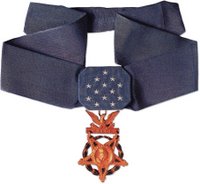GEORGE FRANCIS HENRECHON
Machinist's Mate Second Class, US Navy; USS
Pampanga (PG 39)
Born: 22 November 1885, Hartford, Connecticut
Died: 16 August 1929, Hartford, Connecticut

Citation: While attached to the U.S.S. Pampang, Henrechon was one of a shore party moving in to capture Mundang, Philippine Islands, on 24 September 1911. Ordered to take station within 100 yards of a group of nipa huts close to the trail, Henrechon advanced and stood guard as the leader and his scout party first searched the surrounding deep grasses, then moved into the open area before the huts. Instantly enemy Moros opened point-blank fire on the exposed men and approximately 20 Moros rushed the small group from inside the huts and from other concealed positions. Henrechon, responding to the calls for help, was one of the first on the scene. When his rifle jammed after the first shot, he closed in with rifle, using it as a club to break the stock over the head of the nearest Moro and then, drawing his pistol, started in pursuit of the fleeing outlaws. Henrechon's aggressive charging of the enemy under heavy fire and in the face of great odds contributed materially to the success of the engagement.
JACOB VOLZ
Carpenter's Mate Third Class, US Navy; USS
Pampanga (PG 39)
Born: 23 June 1889, Sutton, Nebraska
Died: 22 July 1965, Portland, Oregon

Citation: While attached to the U.S.S. Pampang, Volz was one of a shore party moving in to capture Mundang, on the island of Basilan, Philippine Islands, on 24 September 1911. Investigating a group of nipa huts close to the trail, the advance scout party was suddenly taken under point-blank fire and rushed by approximately 20 enemy Moros attacking from inside the huts and other concealed positions. Volz responded instantly to calls for help and, finding all members of the scout party writhing on the ground but still fighting, he blazed his rifle into the outlaws with telling effect, destroying several of the Moros and assisting in the rout of the remainder. By his aggressive charging of the enemy under heavy fire and in the face of great odds, Volz contributed materially to the success of the engagement.
JOHN HUGH CATHERWOOD
Ordinary Seaman, US Navy; USS
Pampanga (PG 39)
Born: 7 August 1888, Springfield, Illinois
Died: 18 December 1930, Springfield, Illinois

Citation: While attached to the U.S.S. Pampang, Catherwood was one of a shore party moving in to capture Mundang, on the island of Basilan, Philippine Islands, on the morning of 24 September 1911. Advancing with the scout party to reconnoiter a group of nipa huts close to the trail, Catherwood unhesitatingly entered the open area before the huts, where his party was suddenly taken under point-blank fire and charged by approximately 20 enemy Moros coming out from inside the native huts and from other concealed positions. Struck down almost instantly by the outlaws' deadly fire, Catherwood, although unable to rise, rallied to the defense of his leader and fought desperately to beat off the hostile attack. By his valiant effort under fire and in the face of great odds, Catherwood contributed materially toward the destruction and rout of the enemy.
BOLDEN REUSH HARRISON
Seaman, US Navy; USS
Pampanga (PG 39)
Born: 26 April 1886, Savannah, Tennessee
Died: 26 January 1952, Savannah, Tennessee

Citation: While attached to the U.S.S. Pampang, Harrison was one of a shore party moving in to capture Mundang, on the island of Basilan, Philippine Islands, on 24 September 1911. Harrison instantly responded to the calls for help when the advance scout party investigating a group of nipa huts close to the trail, was suddenly taken under point-blank fire and rushed by approximately 20 enemy Moros attacking from inside the huts and from other concealed positions. Armed with a double-barreled shotgun, he concentrated his blasting fire on the outlaws, destroying 3 of the Moros and assisting in the rout of the remainder. By his aggressive charging of the enemy under heavy fire and in the face of great odds, Harrison contributed materially to the success of the engagement.
Note: Hospital Apprentice Fred H
McGuire also received the Medal of Honor for this action.
 Citation: For distinguished gallantry whilst in command of the sharpshooters furnished by the Coldstream Guards, on the 28th October, 1854, on the occasion of "the powerful sortie on the 2nd Division," when he held the Windmill Ravine, below the Picquet House, against a much larger force of the enemy. The party of sharpshooters then under his command killed thirty-eight (one an officer) and took three prisoners of the enemy, (of the latter, one an Officer) Major Goodlake being the sole Officer in command.
Citation: For distinguished gallantry whilst in command of the sharpshooters furnished by the Coldstream Guards, on the 28th October, 1854, on the occasion of "the powerful sortie on the 2nd Division," when he held the Windmill Ravine, below the Picquet House, against a much larger force of the enemy. The party of sharpshooters then under his command killed thirty-eight (one an officer) and took three prisoners of the enemy, (of the latter, one an Officer) Major Goodlake being the sole Officer in command.
















